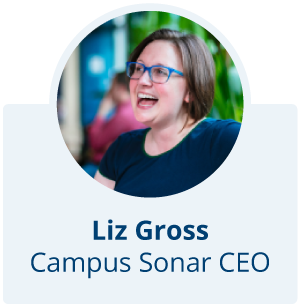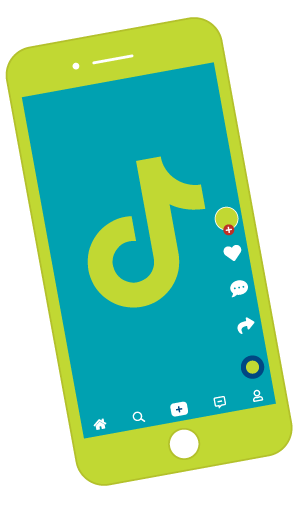Liz's Letter

Sometimes you don’t know what you know. Concepts that always made sense to you (or that you’ve come to understand after prolonged study) or processes that you’ve repeated so many times they feel like second nature are likely not known to others. Identifying what you know particularly well and sharing that knowledge is a way to meaningfully participate in your organization or industry. A stand-out example is Day Kibilds’s award-winning presentation Get. Stuff. Done. from the 2019 HighEdWeb conference. It taught us how to write better emails, document internal processes, and schedule meetings faster. By focusing on important but menial tasks we all do every day, Day highlighted things that come naturally to her and how we can learn them to become more effective professionals.
 I regularly think about the social listening knowledge we take for granted at Campus Sonar. In 2020, we’re going to get better at sharing that knowledge with the community. To get started, here’s a list of things we know about online conversation and higher education that maybe you don’t. If anything is particularly surprising or valuable to you, please reply and let me know. It will help us identify more helpful information we didn’t realize we knew, so we can share it with you.
I regularly think about the social listening knowledge we take for granted at Campus Sonar. In 2020, we’re going to get better at sharing that knowledge with the community. To get started, here’s a list of things we know about online conversation and higher education that maybe you don’t. If anything is particularly surprising or valuable to you, please reply and let me know. It will help us identify more helpful information we didn’t realize we knew, so we can share it with you.
- Generally, two thirds to three quarters of the online conversation about an institution comes from outside the institution (in other words, it’s earned conversation).
- Many campuses promote “official” hashtags that aren’t unique to them, causing brand confusion and complicating engagement efforts and measurement.
- It’s not uncommon for even small campuses to have hundreds of social media accounts purporting to represent the institution, with up to half of them posting nothing for six months or more. This sends mixed messages to prospective students and community members.
- Most campuses have a steady stream of online spam about them—often from essay writing services and local businesses trying to attract students.
- The volume of conversation related to college admissions on Reddit (or at least what can be found with software) is rising year-over-year, while Twitter conversation on the same topic appears to be decreasing.
- High school students are more likely to talk about college on social media after they’ve been admitted to an institution.
- Online, alumni are more likely to be identified in the third person (through news updates or professional bios) than to self-identify in a social media post. This makes monitoring blogs and niche news sources particularly important.
- For institutions with an athletics program, more than half of the online conversation is related to athletics (but it can also have value for admissions and fundraising).
- Student athletes have a very predictable pattern of social media posts about their offers and eventual acceptance to college.
- Most campuses still think about social listening as a way to increase social media engagement—rather than a powerful research method that provides a constant stream of insights about brand, audiences, competitors, … truly any topic.
I hope you enter this holiday season armed with a little more social listening knowledge, and perhaps even more curiosity. I’m sort of giddy about the goodies we’re planning to release next year, so stay tuned. In the meantime, if you’d like us to help you learn more about your institution’s online conversation, reach out. We’d love to customize some research for you, and contextualize it within the trends we’ve identified from examining the online conversation of over 100 campus and industry conversations.

TikTok Explained
by Reed Scherer

As a Social Media Data Analyst for Campus Sonar, I’ve been investigating TikTok both as a general social media platform, but also for its potential as a data source in higher ed focused social listening. I downloaded the app—ahem—strictly for research purposes, of course, and was quickly sucked into the world of teenagers and young adults trying to become famous in 60 seconds or less. Here’s what I discovered over the past few months.
TikTok Basics
TikTok is a mobile-based social media platform that hosts user-created short videos, with video content that varies from trending dances and practical jokes to short skits and miscellaneous clips. The platform supports users in 15 different languages and 75 different countries with 800 million monthly active users. Over one billion videos are viewed globally every single day. Sixty percent of TikTok’s American audience are between the ages of 16 and 24, and 56 percent of app users are male. App users average 52 minutes per day and open the app an average 8 times per day.

One feature that fuels many viral TikTok videos and encourages users to return is the use of artificial intelligence and machine learning. The app tracks the videos users watch and like to provide them with endless content on demand to share on their “For You” page—the main page of the app. It’s easy to see the effectiveness of this feature; if a user clicks the like button on as few as three videos with dogs, for example, they’re sure to see a steady increase in dog videos instantly appear in their feed.
TikTok and Social Listening
 Currently, TikTok isn’t accessible through social listening software because the app doesn’t allow public access to their API (Application Program Interface). Essentially, they don’t allow third parties direct access to their data, unlike Twitter, for example. They may be hesitant to share data because they want to maintain user privacy. If we manually analyzed TikTok’s data, their manual search function is fairly intuitive, but it doesn’t provide nearly the scale we need to monitor brands or topics. They do a great job of showing users content based on prior viewing history, which is a great feature for engagement and user experience, but when I view the content through an analytical lens, there’s a level of bias because the content a user sees on the app is inorganically placed for them. The app shows you what it thinks you want to see, so if we estimated conversation volume, the number is based on the user’s history. As a result, we’re not conducting full social listening on TikTok quite yet, and neither are any other agencies that we’re aware of.
Currently, TikTok isn’t accessible through social listening software because the app doesn’t allow public access to their API (Application Program Interface). Essentially, they don’t allow third parties direct access to their data, unlike Twitter, for example. They may be hesitant to share data because they want to maintain user privacy. If we manually analyzed TikTok’s data, their manual search function is fairly intuitive, but it doesn’t provide nearly the scale we need to monitor brands or topics. They do a great job of showing users content based on prior viewing history, which is a great feature for engagement and user experience, but when I view the content through an analytical lens, there’s a level of bias because the content a user sees on the app is inorganically placed for them. The app shows you what it thinks you want to see, so if we estimated conversation volume, the number is based on the user’s history. As a result, we’re not conducting full social listening on TikTok quite yet, and neither are any other agencies that we’re aware of.
When I looked for metrics and analytics, I found that TikTok offers an internal premium service (TikTok Pro), primarily aimed toward users, that provides basic analytics for their profile. There are also some early third-party services that act as analytics platforms for individual users. These services have serious limitations in terms of scale and capabilities. For example, they only have access to publicly available data such as video views, comments, likes, followers, and basic engagement statistics. They do offer historical TikTok data though, which makes them a unique analytics resource. I see massive potential and significant room for growth in analyzing TikTok’s data; we’re excited to see where it takes us and the information we’re able to research for our higher ed clients.
Learn more about TikTok from Liz and Jess Diluglio from Rochester Institute of Technology on a recent HigherEd Live episode.
Content We're Consuming
 A Guide to Digital Marketing Experimentation and Optimization in Education. Will Patch offers his expertise on testing digital marketing using A/B and multivariate testing.
A Guide to Digital Marketing Experimentation and Optimization in Education. Will Patch offers his expertise on testing digital marketing using A/B and multivariate testing.
 Big Influencers on Campus. Examples of how campuses use influencers, including their processes and helpful guidelines.
Big Influencers on Campus. Examples of how campuses use influencers, including their processes and helpful guidelines.
 Pickle Jar’s Content Strategy Series. Pickle Jar Communications has a three-part series on developing a content strategy for your institution—1. justifying the investment, 2. explaining it to your stakeholders, and 3. getting underway.
Pickle Jar’s Content Strategy Series. Pickle Jar Communications has a three-part series on developing a content strategy for your institution—1. justifying the investment, 2. explaining it to your stakeholders, and 3. getting underway.
 Social Media Trends 2020. From Hootsuite, five distinct social media trends and takeaways for 2020. You can download the report for more on the growth of the new platforms, how marketers use and measure social, and new ways that social engagement delivers relationships and revenue.
Social Media Trends 2020. From Hootsuite, five distinct social media trends and takeaways for 2020. You can download the report for more on the growth of the new platforms, how marketers use and measure social, and new ways that social engagement delivers relationships and revenue.
 To Reach Gen-Z Students, Colleges Meet Them Where They Are—on TikTok. TikTok is a new era in how colleges connect with students, allowing them to have fun, be innovative, and stay current. Examples from the University of Florida, Louisiana State University at Baton Rouge, and Austin Peay. (Chronicle subscription required.)
To Reach Gen-Z Students, Colleges Meet Them Where They Are—on TikTok. TikTok is a new era in how colleges connect with students, allowing them to have fun, be innovative, and stay current. Examples from the University of Florida, Louisiana State University at Baton Rouge, and Austin Peay. (Chronicle subscription required.)
 What to Know About College Admissions Forums. U.S. News & World Report talked to Steve App and other online forum experts on how students use college admissions forums.
What to Know About College Admissions Forums. U.S. News & World Report talked to Steve App and other online forum experts on how students use college admissions forums.
Brain Waves Blog Posts
This month Steve wrote about ... not Reddit, but YouTube (don’t worry, he still mentions Reddit) and Sarah and Rebecca shared their first blog posts—what students say about college finals and top 2020 higher ed conferences, respectively. Find these and more on our blog.
See Campus Sonar
Come see us next year! We’d love to chat with you at an upcoming conference.
Tell Us What You Think
Brain Waves newsletter is for you—help us shape it. Tell us what you think, send ideas, and let us know what would help you do your job better at info@campussonar.com. We want to know!